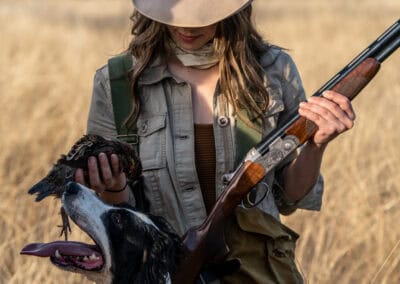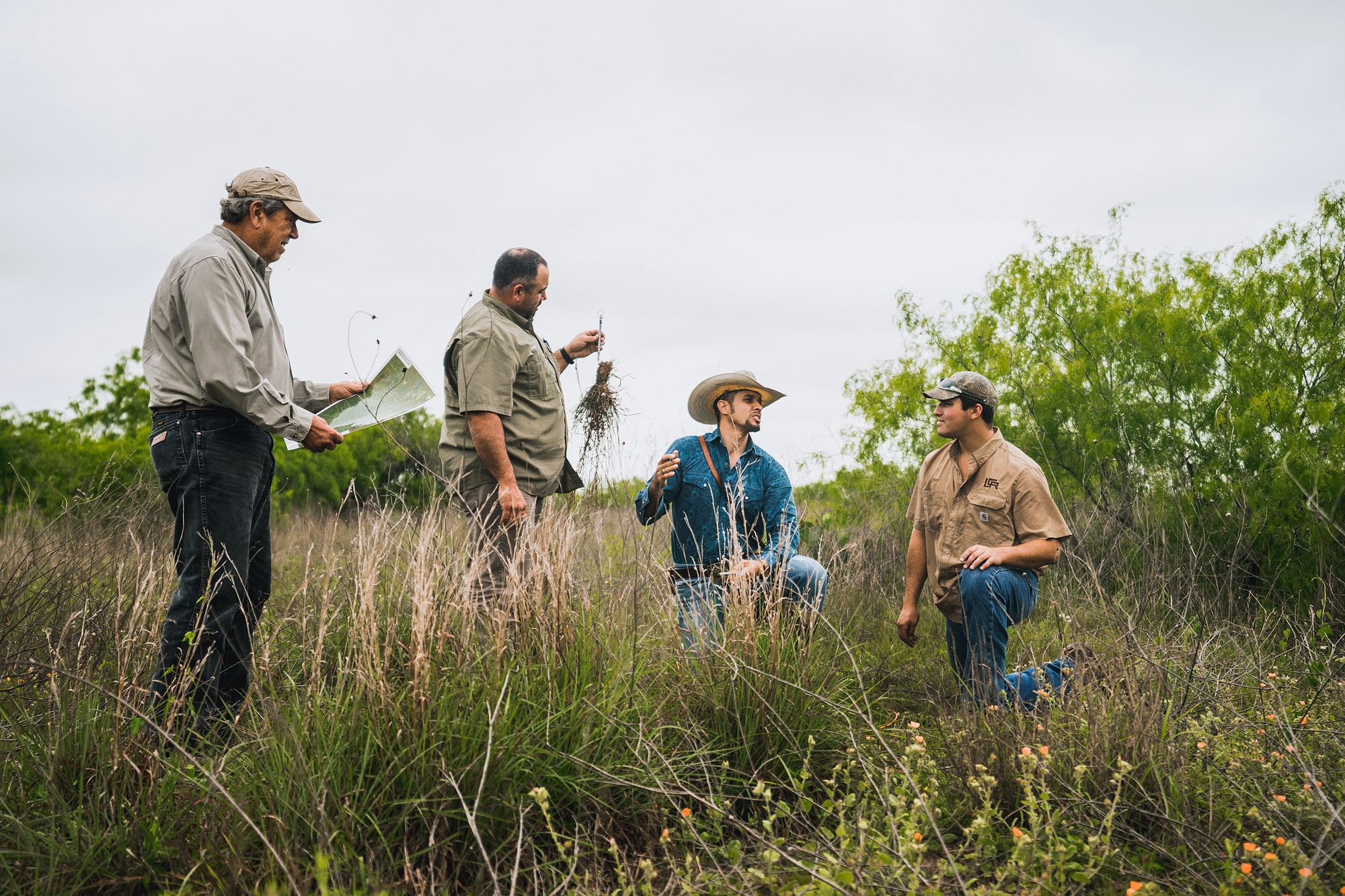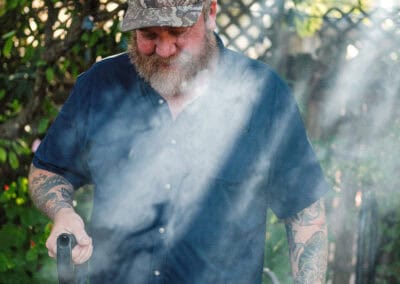Your cart is empty


As the ocean slowly warms in the first hours of daylight, a gentle pressure difference between land and sea begins, blowing a mist of saline and sand further inland than any beach sign may read. Over 10,000 years, this natural seabreeze produced a unique concentration of coastal sand covering roughly 1.5 million acres along the Texas Coast, now formally known as the South Texas Sand Sheet. With each drift of wind, dunes gradually formed, leaving depressions in their valleys that accumulated water. In an otherwise arid desert, wetlands spawned to produce a landscape with diverse vegetation and abundant wildlife. When rain doesn’t fall, the sandy soil becomes a desert not suited for farming, but prime for ranching cattle. This fickle balance determined the future of the landscape.
In 1895, a man by the name of Edward Cunningham Lasater gazed across this sandy landscape with no fence lines in sight and established one of the largest cattle ranches in Texas, covering 350,000 acres. A few years later, he founded the town of Falfurrias, now known among the hunting community for its revered abundance of seasonal game that thrive in the landscape. In those early days, little thought was given to conservation as cattle overgrazed the region, taking their toll on the landscape, and subsequently the wildlife struggle began. By the 1980s, an understanding of the region’s rich biological history moved to the forefront of many cattle ranchers’ awareness, with a new economic engine driving it. Hunting enthusiasm produced income for the region that saved this sandy landscape from an overgrazing demise Today, one such operation, covering 16,000 acres of the former Lasater Ranch, has its focus on continuously improving the land through diligent annual programs that enrich the landscape, increase accessibility, and ultimately benefit the wildlife that call it home. Through no small feat, ranch hands work throughout the year to reach these goals. At Laborcitas Creek Ranch, owner Berdon Lawrence made his passion for hunting into the engine that allows the sandy soil to thrive once again. Ranch Manager David Kelly was gracious enough to share his time and knowledge for a better understanding of how hunting passions cultivate conservation goals in the South Texas Sand Sheet.
John Dunaway: When was Laborcitas Creek Ranch established?
David Kelly: Berdon starting hunting down here in 1989 as an invited guest of Hollywood Camp. He became owner and managed the camp property until 2000. At that time, he purchased the first 6,000 acres and established Laborcitas Creek Ranch from the Miller family, direct descendants of Ed Lasater. Through continued acquisitions, LCR now encompasses 16,000 acres, which is small in Texas ranch terms. Our neighbors to the south and east hold 60,000 acres, and the Jones Ranch to the west is 130,000 acres.
John: What is your management mission?
David: Continuous improvement. We try to enhance the property for the benefit of the wildlife, beautify the surroundings, and improve accessibility. These three are needed and necessary to have a properly managed ranch. It has to be beautiful. It has to be accessible. It has to benefit the wildlife. We try to improve in each category annually to make it better.
John: What are some of the management practices used to support the mission?
David: Controlling invasive species both along the fence lines and across pastures is key. We spot spray, use prescribed burning, and even use customized aerators. One such piece of equipment is our “quaileator,” which pulls behind a tractor, mimicking the footprint of cattle without the negative impacts of their grazing to manipulate the grass and forbs. We try to keep our diversity in plants high to be successful.
You must watch for the encouraging signs as well as the negative. Be observant, communicate and be responsive. It’s a full-time job that all our ranch hands and hunters have to be watching for so we can continuously improve the landscape. Being a region heavily dictated by moisture, we employ 80 water sources to retain the rainfall. Water is piped around the property for irrigation as well as tanks for roaming wildlife. Averaging only 25 inches per year, a shift below this affects all life. Moisture is king.
The Razor HD 10×42 binoculars are best in class. Shop them here
John: Why is the South Texas Land Sheet so advantageous to the landscape?
David: It’s primarily the plant life, which creates unique cover and nutrition for all these animals and reptiles; not only for the deer, turkey, dove and quail, but also the songbirds, butterflies, rabbits and predators. We have the South Texas tortoise, horned lizard, and many varieties of snakes all within this ecosystem due to this unique plant life.
John: Does LCR focus on elevating the landscape for one predominant species or for the whole ecosystem? How do you determine which species is the most important to focus on?
David: We focus on the quail first. As the most fragile element in our ecosystem, managing for them inherently benefits all other wildlife. We employ seasonal practices to support the overall mission.
One example is winter plowing, done in December and January. A 12- foot disc lane in 100–150 yard intervals runs north to south all across the property, opening travel lanes for the wildlife while encouraging plant life to regrow. Forbs, crotons and sunflowers thrive in these new lanes, which are beneficial to supply both nutrition and cover.
We trim mesquite trees in 80–100 yard spacings between groves to improve accessibility. With benefits across the board, this is primarily so we can hunt the quail. The spacing produces an ideal habitat for their range, in loafing, nesting and life in general. If you manage for the quail, you manage for all the wildlife in South Texas.
“It has to be beautiful. It has to be accessible. It has to benefit the wildlife. We try to improve in each category annually to make it better.”
— Ranch Manager David Kelly, Laborcitas Creek Ranch
John: How does employing a low-fence program across larger plots of land affect an ecosystem?
David: The landscape requires genetic diversity, which is only achieved through low fencing. In this region, most ranches are contiguous, so this diversity flourishes. Quail need miles to roam. Bucks in the region cover up to 20 miles, which they cannot obtain under high-fence programs. Without the ability to roam, species of plant and wildlife become constricted from their natural dispersion and suffer from localized issues such as chronic wasting disease.
John: How do landowners in the area work together to pursue this method?
David: We’re fortunate in South Texas to have good partnerships, such as Texas Wildlife Association and South Texas Property Rights Association, of which a lot of the large landowners are members. They become educated on the topics such as low fencing, water management and not overgrazing. It’s an expense, but they are rewarded by achieving higher rent from hunters because of the more abundant and healthier wildlife. Through the increase in hunting, cattle farmers have been able to subsidize their income by leasing these properties. With this shift, they can remove many of the cattle, taking pressure off the land and benefiting the wildlife. It becomes a win/win for all.

John: With these conservation efforts, what have you found returning to the land that suffered previously?
David: With overgrazing, plant life suffered. When plants suffer, the wildlife does too. Reducing the cattle returned concho grass, horsemint, croton — both annuals and perennials — all beneficial to the wildlife. Blue stem, hog plumb, Brazil trees, partridge pea, black-eyed susans and blackfoot daisies. Those plants all suffer during times of overgrazing. You have to have the plant life, the habitat and the moisture.
John: How does a high-fence property negatively impact the local ecosystem? How about the image of hunting?
David: By restricting the distances available to wildlife, these fences curtail their ability to achieve genetic diversity along with the natural spread of plant life. When animals do not roam, those seeds and spores that are carried on their coats also do not move freely across the landscape. New micro-ecosystems are formed within those fence limits. I think the image of hunting also takes a negative impact. In Texas we can feed the animals, but they still have the ability to roam natural distances. On a high-fence property, this is cut off and the hunt is not as challenging. We certainly don’t utilize high fences, except to keep the deer out of our food plots for the birds.
John: Texas is known for its overpopulation of hogs, yet LCR has managed to keep those numbers minimized. What do you attribute this success to? What are the impacts of leaving them unattended to?
David: When they show up, you have to be ready and go get them. Do not let them get ahead of you. We utilize feeders around the property that the hogs cannot refrain from, giving us the first signs of their presence. From blinds and brush stands, they can be hunted to keep those numbers thin prior to their exponential expansion from breeding in the area. A sow averages 1.5 litters per year with 5.5 piglets per litter, allowing them to spread quickly. When left unattended, their rooting method of consuming vegetation scours the landscape far beyond just eating the available nutrition. They reduce the plant life and forage bird nests on the ground while leaving barren earth for the rest of the wildlife. We work hard and it pays off, but it’s a lot of effort to manage them. Ultimately, we put a large emphasis on keeping this invasive species controlled so that our local ecosystem has the best opportunities to reach its highest potential. It’s very important to the management of a wildlife ranch and the landscape as a whole.
JOHN: Do you think that managing wildlife populations through hunting is an important method for effective conservation?
David: Yes I do. We are very fortunate to have an active and knowledgeable system through Texas Parks and Wildlife Department (TPWD). They have regional biologists in every area to help us as ranchers improve our plots. The game laws, which are reviewed by TPWD every year, help tremendously. On big ranches where we’ve earned the right to have a managed land permit, you work with your local biologist to manage the population of deer. Surveys have to be communicated with those biologists. They’ll tell you based on ideal numbers how to harvest your population. We aim for one deer every 20 acres, along with a buck ratio of 1:1. We’re realistically at 1:1.5 for LCR. TPWD does a great job with that, and we owe them a big gratitude for helping us year after year.
Far from the big-city lights, Laborcitas Creek Ranch stirs at all hours in their pursuit to continuously improve the landscape. The Sand Sheet formed itself naturally over 10,000 years, but it requires persistent attention with a managed plan to keep it healthy. Far from the sea, the sand still thrives.
Their efforts have been reflected in earning three major awards for Laborcitas Creek Ranch:
“The Purdey Award USA” for the best quail management and conservation program in Texas.
“The Lone Star Land Stewardship Award” for the best regional land stewardship and management program in South Texas, recognized by the Texas Parks and Wildlife Department.
“The Leopold Award” for the best land stewardship and management program in Texas, recognized by the Sand County Foundation.
This story was originally featured in Modern Huntsman, Volume Three: Wildlife Management with support from Vortex Optics
Related Stories



Latest Stories


